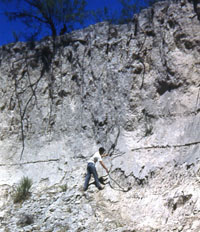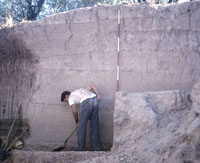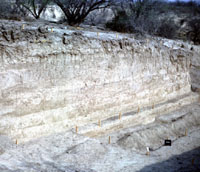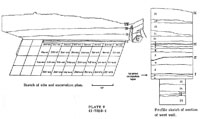Falcon Arroyo
This Archaic campsite along the lower Rio Grande yielded evidence of a deeply buried occupation layer some 10 feet below the surface that contained a suite of artifacts dating to perhaps as early as 3350 B.C. (5,350 years ago). Although the site was excavated and dutifully reported over 50 years ago, it is little known even to most Texas archeologists and its groundbreaking role in the history of archeological research in the region has gone largely unappreciated.
Today the site is officially known as 41SR42 and has never been given a name until now; we�ll call it the Falcon Arroyo site. Today the site lies under the waters of the International Falcon Reservoir in western Starr County. It was tested in the summer of 1950 and excavated in the winter and early spring of 1951 by small archeological teams from the University of Texas as part of the River Basin Surveys, a program of the Smithsonian Institution. The impending completion of the international reservoir threatened the abundant and varied cultural resources lying on both sides of the Rio Grande. On the U.S. side, the archeological investigation of early historic sites dating to the Spanish Colonial period (see Falcon exhibit) and that of the Falcon Arroyo site and several other prehistoric sites was part of the first �salvage� archeology project in the region. The aim of the work was to salvage some of the information that would be soon lost to the rising waters.
The Falcon Arroyo site occupied part of an alluvial terrace (floodplain) of the once mighty Rio Grande. During initial archeological reconnaissance in 1950, archeologist Jack Hughes spotted its deep occupation layers, sandwiched between thick flood deposits, in the steep, eroded bluff of an arroyo that emptied into the Rio Grande. Prior to the construction of flood control dams (such as Falcon and Amistad) and large-scale water diversion for agriculture on both sides of the river, the Rio Grande built up broad, deep alluvial terraces. These terraces, which are sometimes quite broad, have great archeological potential because the frequent flooding through time have deposited thick layers of sand and silt that have sealed (capped) many archeological deposits. This potential, however, has only rarely been tapped by archeologists, in part because of the logistical challenges of conducting deep excavations.
At Falcon Arroyo the excavations concentrated on the deepest occupation layer, which contained many Tortugas dart points, as well as stone adzes, cooking hearths, land snails, chipping debris, and other evidence of hunter-gatherer life. There were three other distinct occupational layers that were less deeply buried, hence not as ancient, but time did not allow excavation of these.
How were the archeologists able to concentrate on the deepest layer? During the testing in 1950, Hughes took advantage of a deep erosional feature�a side arroyo emptying into the main arroyo. The side arroyo had cut deeply into the fine sediment, probably in a single extreme rainfall event (rapid runoff from adjacent uplands), leaving a narrow incised channel with vertical walls. Subsequently, many less intense erosional events (ordinary heavy rains) slowly created small vertical pour-off channels, between which pillars or columns of the original sediment remained. Hughes and several workers used wooden posts and shovels to literally pry off (topple) several pillars of sediment which collapsed into the bottom of the arroyo. The undercut pillars broke off just above the richest cultural zone about 10-11 feet below the surface. This creative overburden removal technique allowed the excavation of one or two 5-x-5� test units that sampled the deep layer. He recommended larger excavations, which were carried out the following year by Donald Hartle.
Toppling convenient sediment pillars would not suffice to create a large excavation area. Fortunately, engineers from the nearby dam construction project kindly provided a bulldozer, which was used to blade away the upper 9 feet of overlying layers as directed by the archeologists. This appears to be the first use of mechanical earthmoving equipment as part of an archeological investigation in the South Texas Plains and one of the first such uses anywhere in Texas. Today such machinery is routinely used in archeological exploration and investigation.
With the overburden stripped away, local workmen led by archeologist Donald Hartle were able to carefully excavate an area that measured 20 by 50 feet of an occupation layer only 4-7� thick. Today such a deposit might be termed a �sealed, single-component occupation,� meaning it was separated (sealed) from other layers by the flood deposits and that it formed during a single relatively short period of time. Such discrete layers are selectively targeted for large-scale investigation and modern researchers often use a similar excavation strategy � machinery to remove overburden and then hand excavation of the most significant and informative layers.
A large sample of charcoal obtained from the targeted �Tortugas layer� resulted in what may have been the very first radiocarbon date from the South Texas Plains. In the early 1950s, radiocarbon dating was still in its infancy and archeologists were just beginning to use the now-standard technique. In 1954 it was reported that a sample of wood charcoal from the Tortugas layer at Falcon Arroyo yielded an assay of 4650 +/- 300 B.P.; when calibrated this assay yields an estimated date of about 3350 B.C. This estimate should be taken with a large grain of salt; radiocarbon dating methods were not well developed back then and it is only a single date. Today radiocarbon dating techniques are much improved and important deposits are routinely dated by multiple samples. Still, the estimated date is plausible, although it falls earlier than recent estimates of the age of Tortugas points.
All in all, the Falcon Arroyo site is remarkable for its ground-breaking role in the history of archeological research in the South Texas Plains. Among its justifiable claims to archeological fame within the region, the Falcon Arroyo site was: the first Archaic site to be excavated; the first use of machinery to facilitate excavation; the first excavation of a sealed, single-component occupation layer; the first site with a radiocarbon date, and one of the first excavations to be photographed in color. Most of this has never been brought to widespread attention until now.
In 1952-1953 archeological and architectural research continued at prehistoric and, especially, Spanish Colonial era sites in the Falcon Reservoir, under the direction of Alex D. Krieger. After the fieldwork ended, Krieger prepared an extensive manuscript that was intended to provide a first-rate synthesis of the Falcon Reservoir work. Alas, the manuscript was never completed or published and the prehistory of the South Texas Plains lapsed into a several-decade period of neglect.
Hindsight tells us that the Falcon Arroyo site had the well-stratified Archaic layers that archeologists have long sought to find and carefully excavate in order to improve our understanding of the prehistory of the South Texas Plains. Its potential was understood by the archeologists who explored the site in the 1950s, but, faced with more archeological opportunities than they had time and the resources to take on, they chose to focus on those relating to the early Spanish Colonial remains in the area. See Falcon Reservoir exhibit to learn more.
Contributed by Steve Black and Mike Quigg.
Sources
Hartle, Donald D. and Robert L. Stephenson
1951 Archeological Excavations at the Falcon Reservoir, Starr County, Texas. River Basin Surveys, Smithsonian Institution.









